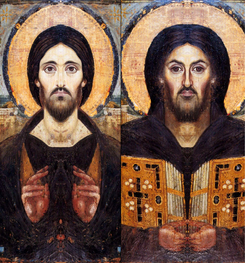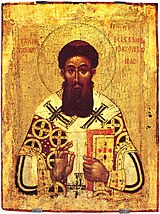|
Hypostatic union
Hypostatic union (from the Greek: ὑπόστασις hypóstasis, 'person, subsistence') is a technical term in Christian theology employed in mainstream Christology to describe the union of Christ's humanity and divinity in one hypostasis, or individual personhood.[1] In the most basic terms, the concept of hypostatic union states that Jesus Christ is both fully God and fully man. He is simultaneously perfectly divine and perfectly human, having two complete and distinct natures at once. The Athanasian Creed recognized this doctrine and affirmed its importance by stating:
Hypostasis  The Greek term hypostasis (ὑπόστασις) had come into use as a technical term prior to the Christological debates of the late fourth and fifth centuries. In pre-Christian times, Greek philosophy (primarily Stoicism) used the word.[4][5] Some occurrences of the term hypostasis in the New Testament foreshadow the later, technical understanding of the word.[6] Although it can translate literally as "substance", this has been a cause of some confusion;[7] accordingly the New American Standard Bible translates it as "subsistence". Hypostasis denotes an actual, concrete existence, in contrast to abstract categories such as Platonic ideals. In Kierkegaard's Philosophical Fragments, the dual nature of Christ is explored as a paradox, i.e. as "the ultimate paradox", because God, understood as a perfectly good, perfectly wise, perfectly powerful being, fully became a human, in the Christian understanding of the term: burdened by sin, limited in goodness, knowledge, and understanding.[8] This paradox can only be resolved, Kierkegaard believed, by a leap of faith away from one's understanding and reason towards belief in God. As the precise nature of this union is held to defy finite human comprehension, the hypostatic union is also referred to by the alternative term "mystical union". Through history
Apollinaris of Laodicea was the first to use the term hypostasis in trying to understand the Incarnation.[9] Apollinaris described the union of the divine and human in Christ as being of a single nature and having a single essence — a single hypostasis. Council of EphesusIn the 5th century, a dispute arose between Cyril of Alexandria and Nestorius in which Nestorius claimed that the term theotokos could not be used to describe Mary, the mother of Christ. Nestorius argued for two distinct substances or hypostases, of divinity and humanity, in Christ. He maintained that divinity could not be born from a human because the divine nature is unoriginate. The Council of Ephesus in 431, under the leadership of Cyril himself as well as the Ephesian bishop Memnon, labeled Nestorius a neo-adoptionist, implying that the man Jesus is divine and the Son of God only by grace and not by nature, and deposed him as a heretic. In his letter to Nestorius, Cyril used the term "hypostatic" (Greek, καθ᾽ ὑπόστασιν kath' hypóstasin) to refer to Christ's divine and human natures being one, saying, "We must follow these words and teachings, keeping in mind what 'having been made flesh' means .... We say ... that the Word, by having united to himself hypostatically flesh animated by a rational soul, inexplicably and incomprehensibly became man." Cyril also stressed on "μία φύσις τοῦ θεοῦ λόγου σεσαρκωμένη, meaning "one physis ["nature"] of the Word of God made flesh" (or "one physis of God the Word made flesh")"[10] Council of ChalcedonThe preeminent Antiochene theologian Theodore of Mopsuestia, contending against the monophysite heresy of Apollinarism, is believed to have taught that in Christ there are two natures (dyophysite), human and divine, and two corresponding hypostases (in the sense of "subject", "essence" but not "person") which co-existed.[11] However, in Theodore's time the word hypostasis could be used in a sense synonymous with ousia (which clearly means "essence" rather than "person") as it had been used by Tatian and Origen. The Greek and Latin interpretations of Theodore's Christology have come under scrutiny since the recovery of his Catechetical Orations in the Syriac language. In 451, the Ecumenical Council of Chalcedon promulgated the Chalcedonian Definition. It agreed with Theodore that there were two natures in the Incarnation. However, the Council of Chalcedon also insisted that hypostasis be used as it was in the Trinitarian definition: to indicate the person (prosopon) and not the nature as with Apollinaris. Oriental Orthodox rejection of Chalcedonian definitionThe Oriental Orthodox Churches, having rejected the Chalcedonian Definition, were known as Miaphysites because they maintain the Cyrilian definition that characterized the incarnate Son as having one nature. The Chalcedonian "in two natures" formula (based, at least partially, on Colossians 2:9) was seen as derived from and akin to a Nestorian Christology.[12] Contrariwise, the Chalcedonians saw the Oriental Orthodox as tending towards Eutychian Monophysitism. However, the Oriental Orthodox persistently specified that they have never believed in the doctrines of Eutyches, that they have always affirmed that Christ's humanity is consubstantial with our own, and they thus prefer the term Miaphysite to be referred to as a reference to Cyrillian Christology, which used the phrase "μία φύσις τοῦ θεοῦ λόγου σεσαρκωμένη", "mía phýsis toû theoû lógou sesarkōménē". The term miaphysic means one united nature as opposed to one singular nature (monophysites). Thus the Miaphysite position maintains that although the nature of Christ is from two, it may only be referred to as one in its incarnate state because the natures always act in unity. In 1989 and 1990, leaders from the Eastern Orthodox and Oriental Orthodox churches signed joint statements[13] in an attempt to work towards reunification (for more, see Miaphysitism). Likewise the leaders of the Assyrian Church of the East, which venerates Nestorius and Theodore, in 1994 signed a joint agreement with leaders of the Roman Catholic Church acknowledging that their historical differences were over terminology rather than the actual intended meaning. See alsoReferences
Sources
External linksLook up hypostasis in Wiktionary, the free dictionary.
|
